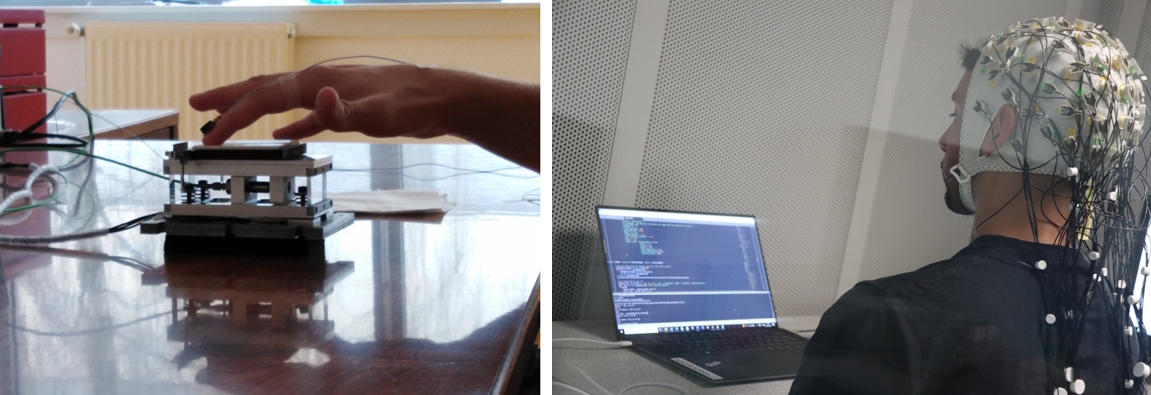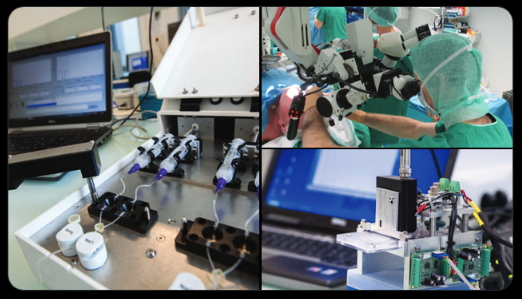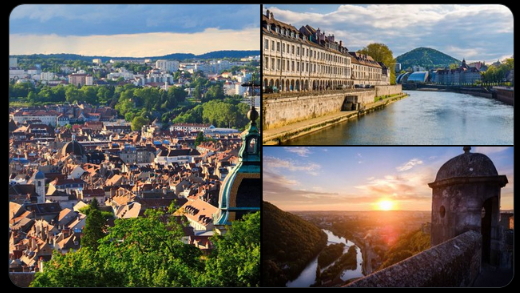Postdoc position
posted on November 16, 2023
Postdoc position: Parametric texture generation and manufacturing at the micro-nano-meter scale for tactile psychophysics
Application deadline: Feb. 29th, 2024
Start date: March-May, 2024
The Femto Neuro group and the Mecanochemistry and Tribology team, FEMTO-ST Institute in Besançon, France are seeking applications for a Postdoctoral position (1 year, with a possible 1-year extension) at the intersection of the three domains of computer graphics/applied maths, material science/micro-nano manufacturing and psychophysics/haptics research. The position will be based in Besançon, France.
The position is funded by CNRS, with the generous support of Région Bourgogne Franche-Comté (Project ASPECT - Automatique des systèmes perceptifs) and EIPHI Graduate School (Project STARTREC - Studying the tactile perception of textures through reverse correlation).
The science
Tactile perception results from the activation of populations of skin mecanoreceptors which respond selectively to the mechanical forces and vibrations induced by friction when the finger explores a spatial texture, with spatial sensitivity down to the nanometer scale (Skedung et al. Scientific Reports 2013). The response of mechanoreceptors is then propagated to the central nervous system, and processed to create percepts of whether the surface is e.g. soft, rough, slick or sticky (McGlone, Wessberg, & Olausson, Neuron 2014).
Contrary to vision or hearing for which clear psychophysical links have been established between the physical properties of a stimulus and their psychological correlates, the sense of touch remains poorly understood. This is partly owing to the fact that, contrary to sound and image stimuli which can be synthesized algorithmically with advanced parametric control (see e.g. Arias et al. Emotion Review 2021 for voice; Yu et al. Multimedia Tools and Applications 2015 for faces), generating surface samples for psychophysics research at the appropriate scale and level of spatial complexity remains remarkably challenging. Existing studies have either used textures that have the appropriate (nm-μm) scale but can only be manufactured with limited spatial complexity (e.g. strain-induced wrinkles in PDMS; Skedung et al. Scientific Reports 2013) or textures that have complex parametric statistics but can only be manufactured at the macroscopic scale (Sahi et al. Scientific Reports 2020).

Figure: Example of surface stimuli used in previous tactile research. (a) Surface wrinkling of polydimethylsiloxane (PDMS), formed spontaneously upon applying a mechanical stress to a bilayer system where the top layer has a higher elastic modulus. Wrinkle wavelengths range from 300 nm to 90 μm and amplitudes between 7 nm and 4.5 μm; Skedung et al. Scientific Reports 2013. (b) 50 square-mm surfaces with random roughness, printed by polygraphic printing in polymethyl methacrylate (PMMA) at the 0.1-1mm scale; Sahi et al. Scientific Reports 2020 .
The goal of this postdoctoral project is to bridge this gap and to design and manufacture surfaces with complex parametric textures using state-of-art micro-nano-scale fabrication techniques. The project lies at the interface between applied maths/computer modeling, material science/micro-fabrication and psychophysics.
At the modeling level, the postdoctoral fellow will investigate novel algorithms to generate stochastic surface topographies using statistical parameters that are compatible with both the constraints of tactile physiology (i.e. patterns that can be perceived) and micro-fabrication techniques (i.e. patterns that can be manufactured). This can take inspiration from modeling work in the domain of auditory texture synthesis (McDermott & Simoncelli, Neuron 2011) or procedural terrain generation in computer graphics (Ebert et al. 2002)

Figure: Example of procedural textures generation. (a) Analysis and resynthesis of auditory textures from statistical moments (McDermott & Simoncelli, Neuron 2011). (b) Two-dimensional slice through 3D “Perlin” gradient noise, generated with https://github.com/blackears/PerlinNoiseMaker
For micromanufacturing, the project builds on the availability of the MIMENTO technology center, a major national-scale resource for micro-fabrication and nanotechnologies. Co-located with the FEMTO-ST Institute in Besançon, the MIMENTO platform offers more than 800 sq-meter of clean room and more than 20M€ state-of-art equipment in lithography and 3D laser microfabrication. Of particular interest for the project, the postdoctoral fellow will be able to explore femtosecond laser-based micromachining processes in photosensitive polymers (Nanoscribe) and in hard glass-type materials (FEMTOprint).

Finally, the fabricated surfaces will be tested as material for psychophysical experiments on tactile perception, using the paradigm of reverse correlation (e.g. Ponsot et al. PNAS 2018) with simultaneous measurements of contact forces and friction-induced vibrations, made with custom tribometers. For this, the postdoctoral fellow will be able to access the facilities and equipment of the Femto Neuro group (for human participant research) and the ECTO team (for tribology experiments).

All in one, this project presents an exciting mix of science and technology, both computational and material, all in the aim to tackle a fundamental question about tactile perception with wide ranging applications, from e.g. surface conception for product design to the assessment of pathologies of tactile perception.
McGlone, F., Wessberg, J., & Olausson, H. (2014). Discriminative and affective touch: sensing and feeling. Neuron, 82(4), 737-755. link
Arias, P., Rachman, L., Liuni, M., & Aucouturier, J. J. (2021). Beyond correlation: acoustic transformation methods for the experimental study of emotional voice and speech. Emotion Review, 13(1), 12-24. link
Yu, H., Garrod, O., Jack, R., & Schyns, P. (2015). A framework for automatic and perceptually valid facial expression generation. Multimedia tools and applications, 74, 9427-9447. link
Skedung, L., Arvidsson, M., Chung, J. Y., Stafford, C. M., Berglund, B., & Rutland, M. W. (2013). Feeling small: exploring the tactile perception limits. Scientific reports, 3(1), 2617. link
Sahli, R., Prot, A., Wang, A., Müser, M. H., Piovarči, M., Didyk, P., & Bennewitz, R. (2020). Tactile perception of randomly rough surfaces. Scientific reports, 10(1), 15800. link
McDermott, J. H., & Simoncelli, E. P. (2011). Sound texture perception via statistics of the auditory periphery: evidence from sound synthesis. Neuron, 71(5), 926-940. link
Ebert, D. S., Musgrave, F. K., Peachey, D., Perlin, K., & Worley, S. (2002). Texturing and Modeling: A Procedural Approach. Elsevier.
link
Ponsot, E., Burred, J.J., Belin, P. & Aucouturier, JJ. (2018) Cracking the social code of speech prosody using reverse correlation. Proceedings of the National Academy of Sciences, vol 115 (15) 3972-3977 link
The environment
The project is a ongoing collaboration between the Femto Neuro group and the Mecanochemistry and Tribology team, FEMTO-ST Institute in Besançon, France. The fellow will be supervised by Dr Jean-Julien Aucouturier (Directeur de recherche CNRS, Neuro team) and Prof. Pierre-Henri Cornuault (Prof. Université de Franche-Comté, ECTO team).
 With more than 750 researchers, the FEMTO-ST Institute (CNRS/Université de Bourgogne Franche-Comté) is the region’s largest engineering CNRS lab, with expertise covering all fields of system science. The neuro group is based in FEMTO’s Department of Automation and Robotics, which hosts about 80 researchers active in the fields of robotics, mechatronics, automatic control and artificial intelligence. The ECTO team is based in FEMTO’s Department of Applied Mechanics which hosts about 110 researchs active in the field of materials, surfaces, processes and structures.
With more than 750 researchers, the FEMTO-ST Institute (CNRS/Université de Bourgogne Franche-Comté) is the region’s largest engineering CNRS lab, with expertise covering all fields of system science. The neuro group is based in FEMTO’s Department of Automation and Robotics, which hosts about 80 researchers active in the fields of robotics, mechatronics, automatic control and artificial intelligence. The ECTO team is based in FEMTO’s Department of Applied Mechanics which hosts about 110 researchs active in the field of materials, surfaces, processes and structures.
 A world-heritage UNESCO site close to the French-Swiss mountains of Jura, Besançon is a vibrant, mid-size regional capital city regularly ranking best-in-France for its quality of life and surface green spaces per inhabitant, but also boasts a newly-federated university (Université de Bourgogne Franche-Comté) of more than 50k students.
A world-heritage UNESCO site close to the French-Swiss mountains of Jura, Besançon is a vibrant, mid-size regional capital city regularly ranking best-in-France for its quality of life and surface green spaces per inhabitant, but also boasts a newly-federated university (Université de Bourgogne Franche-Comté) of more than 50k students.
Applicants
The ideal applicant for this position holds a PhD with a background either in computer modeling and applied maths (with an appetite for material science and micro-fabrication), or in material science and microfabrication (with an appetite for computer modeling and applied maths).
The project offers the best training potential for applicants who already have a solid programming background in Python or Matlab.
Experience with 3D laser microfabrication and/or lithography at the micro-scale will be considered an asset, but is not a requirement (as the MIMENTO facilities offers ad-hoc technical training for these technologies). Similarly, experience with tactile perception research or psychophysics in general will be considered an asset, but is not a requirement.
How to apply:
Applications must be done via the CNRS employment portal, at this link. The portal is opened for application from Dec. 1st, 2023 to Feb. 29th, 2024.
Application material:
- curriculum vitae
- motivation letter detailing past experiences that are relevant for the project
- name of 2-3 referees who could provide reference letters if needed
Application period: Dec 1st, 2023 - Feb. 29th, 2024
Application deadline: Feb. 29th, 2024
Interviews conducted: January - March 2024
Start date: within March-May 2024 (1 year, fulltime, potentially renewable 1 extra year)
For informal enquiries (but not for application, which should go here), please contact:
Jean-Julien Aucouturier (aucouturier@gmail.com) and Pierre-Henri Cornuault (pierre_henri.cornuault@univ-fcomte.fr)